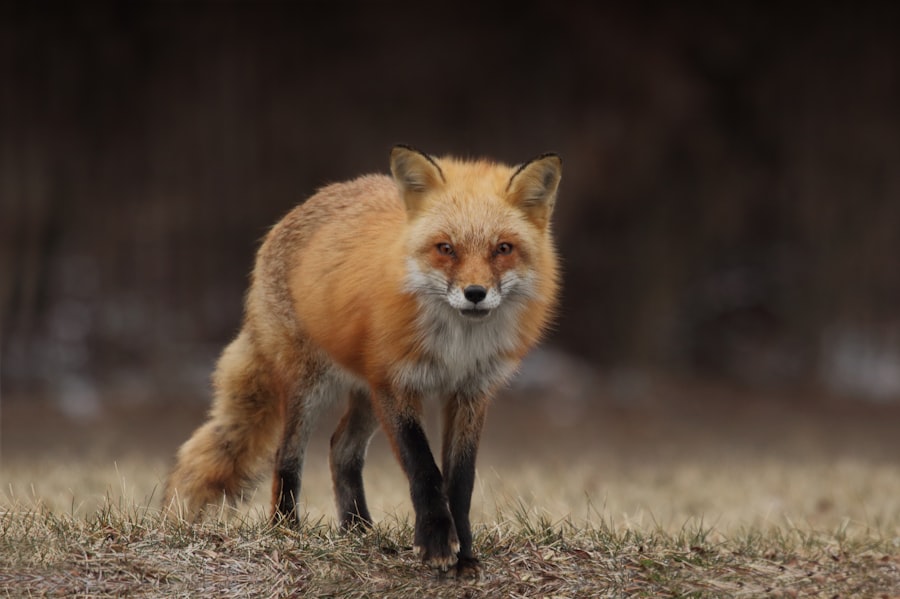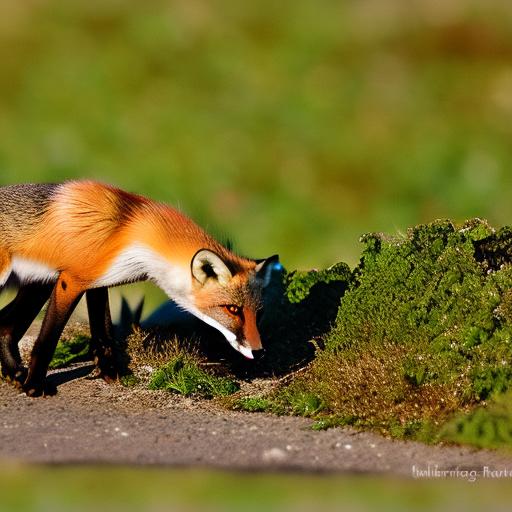Geese can be a nuisance in many areas, causing damage to crops, leaving behind droppings, and creating noise and mess. Finding effective and humane methods to deter geese is important for maintaining the cleanliness and safety of these areas. One method that has gained popularity is the use of decoy foxes. These decoys are designed to mimic the appearance of a real fox, which is a natural predator of geese. By placing these decoy foxes in strategic locations, it is believed that they can help keep geese away.
Key Takeaways
- Decoy foxes can be used to deter geese from certain areas
- Geese are attracted to areas with open water and short grass
- Decoy foxes can help keep geese away by creating a sense of danger
- Factors to consider when selecting a decoy include size, color, and material
- Decoy foxes should be placed in areas where geese are likely to land or feed for maximum effectiveness
The behavior of geese: Why they are attracted to certain areas
Understanding the behavior of geese is crucial in finding effective ways to deter them. Geese are attracted to areas that provide them with food, water, and shelter. They are herbivores and feed on grass, grains, and other vegetation. Areas with lush green grass and open water sources are particularly attractive to geese. They also prefer areas with minimal human disturbance, as it provides them with a sense of safety.
The problems caused by geese in these areas are numerous. Their droppings can create unsightly messes and pose health risks. Geese can also damage crops by trampling on them or eating the plants. In addition, their constant honking and aggressive behavior can be disruptive and intimidating to people in these areas.
The role of decoy foxes: How they can help keep geese away
Decoy foxes work by exploiting the natural fear that geese have towards predators. Foxes are natural predators of geese, so the presence of a decoy fox can create a sense of danger for the geese. This fear can cause them to avoid the area altogether or be more cautious when approaching it.
The effectiveness of decoy foxes as a geese deterrent has been supported by anecdotal evidence and some studies. Many people have reported success in using decoy foxes to keep geese away from their properties. However, it is important to note that the effectiveness may vary depending on the specific circumstances and the behavior of the geese in the area.
Choosing the right decoy fox: Factors to consider when selecting a decoy
When selecting a decoy fox, there are several factors to consider. The size of the decoy is important, as it should be large enough to be visible from a distance but not so large that it becomes unrealistic. The material of the decoy is also important, as it should be durable and weather-resistant. Common materials used for decoy foxes include plastic, foam, and wood.
It is also important to choose a realistic-looking decoy. Geese are intelligent animals and can quickly learn to distinguish between real and fake threats. A realistic-looking decoy will be more effective in creating a sense of danger for the geese.
Placement of decoy foxes: Where to position them for maximum effectiveness
The placement of decoy foxes is crucial for their effectiveness. They should be positioned in areas where geese are likely to congregate or feed. This could include open fields, near bodies of water, or near areas with lush vegetation.
It is also important to change the position of the decoy foxes regularly. Geese can quickly become accustomed to their presence if they remain in the same location for an extended period of time. By moving the decoys around, it creates a sense of unpredictability and makes it more difficult for geese to become comfortable in the area.
Maintenance of decoy foxes: How to keep them in good condition

To ensure the maximum effectiveness of decoy foxes, it is important to properly maintain them. This includes cleaning them regularly to remove dirt and debris. It is also important to store them properly when not in use, as exposure to the elements can cause damage to the decoys.
Regular inspection of the decoy foxes is also important to check for any signs of wear or damage. If any damage is found, it should be repaired or replaced as soon as possible to maintain the realistic appearance of the decoy.
Alternatives to decoy foxes: Other methods for deterring geese
While decoy foxes have been proven to be effective in deterring geese, there are also other methods that can be used. One common method is the use of noise makers, such as propane cannons or bird distress calls. These noise makers create loud and unexpected sounds that can scare away geese.
Another method is the use of repellents, such as chemical sprays or visual deterrents. Chemical sprays can be applied to areas where geese are likely to feed, making the food source unappealing to them. Visual deterrents, such as scarecrows or reflective tape, can create a sense of danger for geese and deter them from approaching.
Potential drawbacks of using decoy foxes: Possible negative effects on other wildlife
While decoy foxes can be an effective method for deterring geese, there are potential drawbacks that need to be considered. One potential negative effect is the impact on other wildlife. Decoy foxes may attract other predators, such as coyotes or birds of prey, which could pose a threat to other animals in the area.
To minimize these negative effects, it is important to regularly monitor the area and remove any real predators that may be attracted to the decoy foxes. It is also important to choose a realistic-looking decoy that closely resembles a fox, as this will reduce the likelihood of attracting other predators.
Success stories: Examples of how decoy foxes have helped keep geese away
There have been many success stories of how decoy foxes have been used to effectively deter geese. For example, in a park in Canada, decoy foxes were placed near a pond where geese had been causing problems. The presence of the decoy foxes caused the geese to avoid the area, allowing the park to remain clean and safe for visitors.
In another example, a golf course in the United States had been struggling with geese causing damage to the greens and fairways. After placing decoy foxes around the course, the geese were deterred from landing and feeding, allowing the golf course to maintain its pristine condition.
The effectiveness of using decoy foxes as a geese deterrent
In conclusion, using decoy foxes can be an effective method for deterring geese from problem areas. By exploiting the natural fear that geese have towards predators, decoy foxes create a sense of danger that can cause geese to avoid or be more cautious in certain areas.
However, it is important to consider other methods and factors when deterring geese. Decoy foxes should be used in conjunction with other methods, such as noise makers or repellents, for maximum effectiveness. It is also important to regularly monitor and maintain the decoy foxes to ensure their realistic appearance and effectiveness.
Overall, using humane and effective methods to deter geese is crucial for maintaining the cleanliness and safety of affected areas. By understanding the behavior of geese and implementing appropriate deterrent methods, we can coexist with these animals while minimizing the problems they cause.
If you’re looking for effective ways to protect your geese from foxes, you might be interested in this informative article on Poultry Wizard’s website. They discuss the use of decoy foxes as a deterrent for keeping geese safe. To learn more about this method and other strategies for safeguarding your poultry, check out their article: “Rent a Chicken Coop: A Practical Solution for Poultry Safety”.
FAQs
What is a decoy fox?
A decoy fox is a life-size replica of a fox that is used to deter geese and other birds from landing or nesting in a particular area.
How does a decoy fox work?
A decoy fox works by mimicking the presence of a predator in the area. Geese and other birds are naturally afraid of foxes, so the sight of a decoy fox can be enough to keep them away.
Will a decoy fox keep geese away?
It is possible that a decoy fox will keep geese away, but it is not guaranteed. Geese are intelligent birds and may eventually realize that the decoy is not a real threat. Additionally, if the geese are already nesting in the area, a decoy fox may not be effective in deterring them.
Where should a decoy fox be placed?
A decoy fox should be placed in an area where geese and other birds are likely to land or nest. This could include near a pond or lake, on a golf course, or in a park.
Do decoy foxes require maintenance?
Decoy foxes do not require much maintenance, but they should be periodically moved to different locations to prevent geese from becoming accustomed to their presence. Additionally, decoy foxes should be cleaned regularly to prevent the buildup of dirt and debris.
Meet Walter, the feathered-friend fanatic of Florida! Nestled in the sunshine state, Walter struts through life with his feathered companions, clucking his way to happiness. With a coop that’s fancier than a five-star hotel, he’s the Don Juan of the chicken world. When he’s not teaching his hens to do the cha-cha, you’ll find him in a heated debate with his prized rooster, Sir Clucks-a-Lot. Walter’s poultry passion is no yolk; he’s the sunny-side-up guy you never knew you needed in your flock of friends!







